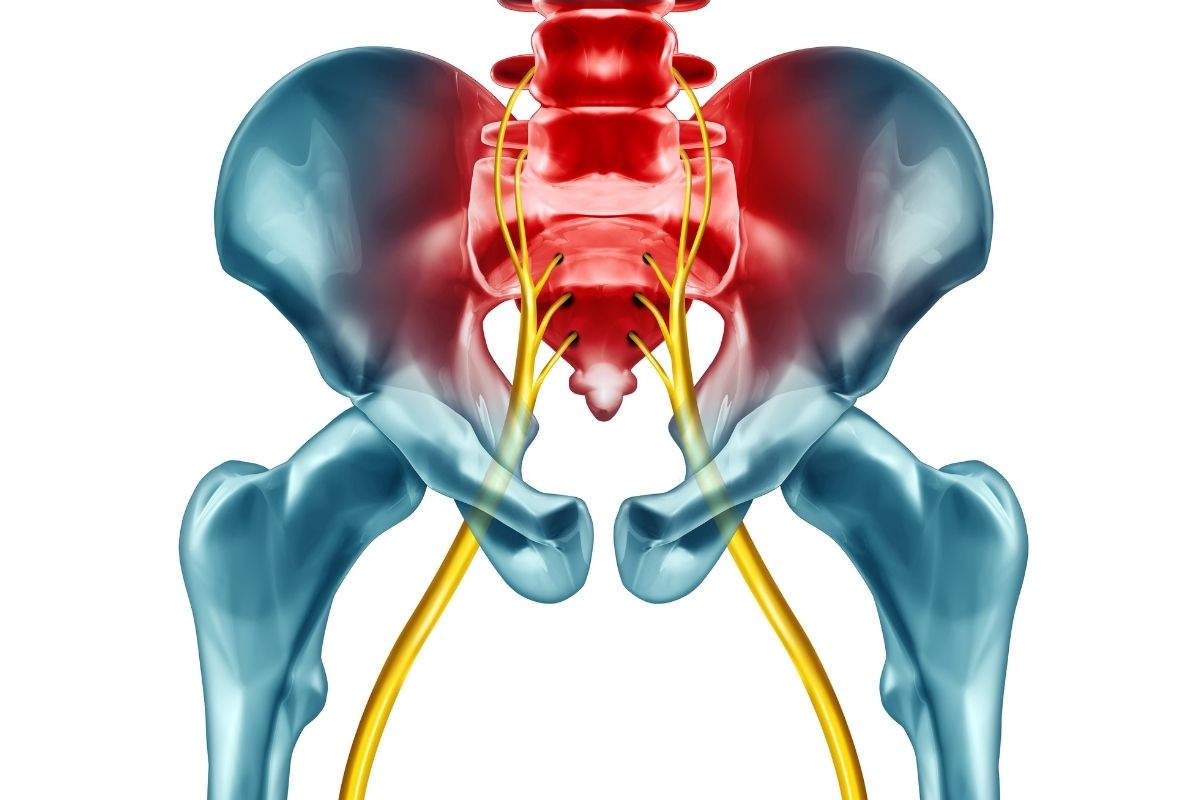Sciatica Physiotherapy: Treatments & Exercises to Reduce Pain

Physiotherapy treatment has been shown to help alleviate pain associated with sciatica by reducing inflammation and relieving muscle tension. The goal is to ease the symptoms of sciatica, allowing you to return to your favourite activities without discomfort. Our physiotherapists will work with you one-on-one to find out what’s causing your sciatica and how best to treat it. Physiotherapy treatment consists of non-invasive techniques to relieve muscle tension and promote healing.
What is Sciatica?
Sciatica is an umbrella term used to describe pain that travels down the back of the buttocks and leg, as low as the feet and toes. Pain is usually caused by an irritation to the sciatic nerve (typically at the level of your buttock), or the nerve roots in your lower back, which give rise to the sciatic nerve. There can also be symptoms such as altered sensation, tingling and muscle weakness.
Despite popular opinion, you don’t necessarily need to have lower back pain to have sciatica. You can have symptoms and leg pain in your lower limb without having any back pain at all.

How long does Sciatica last?
Most cases of sciatica resolve within 4 to 8 weeks with appropriate physiotherapy management. If symptoms are more severe and include numbness, tingling and associated muscle weakness, it may take longer.
Sciatica rarely requires surgery; however, in rare circumstances where there is severe nerve compromise, such as altered sensation in the saddle region or impaired bladder or bowel control, surgery may be indicated.
What are the causes of Sciatica?
Often, there is no moment of onset for sciatica, and it tends to develop over a period of time. A 2007 study found that a common cause of sciatica is engaging in physically demanding work, such as manual labourers and truck drivers. Specifically, common causes include those who are required to bend their spine repeatedly, which may increase their risk of developing sciatica.
The nerves that supply your leg originate from your spinal cord, which exits through little spaces in the side of your lower back. These small nerves (called nerve roots) join together and form the large nerve known as the sciatic nerve. This nerve then passes down through the pelvis into the buttocks, where it passes through the muscles in your bottom and finally travels down into your leg.
Sciatica’s common causes include:
1) Compression and irritation of the nerve roots close to your spine by issues like a herniated disc or inflammation, causing increased pressure on the nerves. It can also be caused by other spine issues such as a spondylolisthesis or spinal stenosis.
2) Compression and irritation of the sciatic nerve, which passes through your buttocks and travels down your leg. This can be caused by a muscle irritating the sciatic nerve as it passes through it.
Essentially, sciatica is an irritation of the nerves in your lower back, or in your buttock.
What are the symptoms of Sciatica?
The hallmark symptom of sciatica is pain; the type of pain can vary:
- It may be sharp, feel like electric shocks, discomfort or numbness.
- There can also be sensations such as tingling and a feeling of weakness in your leg, ankle, and/or foot.
- The pain is typically situated in the buttocks and lower back region, but can extend down into the hamstrings, calves and feet (leg pain).
- Symptoms are typically one-sided rather than affecting both legs. In rare cases, you can have leg pain in both legs.
- Can have lower back pain.
These can be aggravated by coughing or sneezing, as well as by moving from a sitting to a standing position, prolonged sitting, or changing from a standing to a lying position.
How is Sciatica diagnosed?
Sciatica is diagnosed by a cluster of findings in your history and physical assessment by your physiotherapist. Your therapist will conduct several physical tests to determine the origin of your sciatic pain, including muscle strength tests, nerve mobility tests, and lumbar range of motion tests.
We will also want to know if you’ve had an injury, fever, problems controlling your bowels or bladder, previous cancers and whether you’ve been losing weight without trying. The answers to these questions are important because if these symptoms are present, the cause of sciatica could be a serious condition, such as a bone fracture, infection or cancer. These are rare, however.
Do I need a scan?
The majority of cases do not require any imaging and typically resolve within 4-8 weeks with targeted physiotherapy intervention. However, if symptoms persist beyond 8 weeks of physiotherapy intervention, further medical investigation and management may be required.
How can my Physiotherapy help me?
1) Sciatica treatment in the early stages involves a strong focus on reducing your pain with manual therapy, dry needling, gentle nerve stretching, and spinal mobility work to reduce the sensitivity of the irritated nerve. This usually yields great relief and a significant reduction in symptoms in 1-4 visits.
2) Ensuring long-term results and minimising the chance of your symptoms returning by completing a personalised rehabilitation plan. There’s a structured approach to ensuring we address sciatica properly (see the exercises below, categorised by early, mid, and late stages). Getting you pain-free is our first priority, but it’s our attention to detail in helping you rehabilitate through the entire journey that ensures our results are unrivalled and your symptoms don’t return.
This involves strengthening exercises that target the muscles that support your lower back and buttocks. This is vitally important, as it will enable your body to cope with the demands placed on it day-to-day, as well as any recreational activities you enjoy. A robust long-term management plan also involves targeted nerve mobility exercises to improve the movement of your affected nerves, as well as spinal mobility exercises to improve the movement of your spine.
3) Ensuring you have no lingering weakness that will affect your function and quality of life moving forward. With moderate to severe sciatica symptoms, once your pain resolves, there’s often some leftover weakness that makes your usual tasks harder than they’d typically be. To get back to your usual self, this needs to be addressed. A thorough Physiotherapy assessment can help identify what’s lacking and provide you with the knowledge to address it.
4) Advice and education on positioning, posturing and the level of activity suitable for you to allow your symptoms to settle and keep you comfortable whilst our treatment is having the desired effect. We’ll also provide you with the guidance you need to gradually return to the activity level you want in a safe and non-detrimental manner.
A big part of your rehabilitation once your initial symptoms have settled is ensuring there’s no residual sensitivity of your nerve, whilst working on the strength of your lumbar spine, pelvis and leg muscles.
Early-stage Sciatica relief exercises/stretches
These exercises serve as a great starting point for managing acute sciatica. If any of the exercises cause the pain to worsen after completing them, stop immediately.
Mid-stage Sciatica relief exercises/stretches
Click here for MID STAGE exercises.
Following the early-stage sciatica exercises above, the exercise progressions begin to apply more tension to your nervous system, improving its mobility, reducing its sensitivity, and further alleviating your symptoms. In these exercises, a ‘slump’ or rounded low back has been introduced, which places further tension on the nervous system than if one were to sit tall.
These exercises are ideal if you are experiencing mild symptoms or if your pain is subsiding well from an acute or severe episode of sciatica.
Late-stage Sciatica relief exercises/stretches
Click here for LATE STAGE exercises.
These exercises are the most demanding on your nervous system and are sure to provide a powerful stretch to help keep your symptoms at bay.
In addition to this, a strength program that targets our lower back, glutes and core can be very effective in preventing sciatica from returning.



In summary, sciatica is a very common and treatable condition that can be effectively managed with good-quality physiotherapy. It rarely requires scans or more invasive interventions such as cortisone injections or surgery.
It’s essential to keep in mind that recovery from this type of thing can be gradual. If those suffering from sciatica do the right thing for long enough while avoiding aggravating activities, relief will result for the vast majority of people.
You can take the first step to resolve your sciatica pain by booking online here to see one of our expert physiotherapists today!
Alternatively, if you are unsure about what to do next, please don’t hesitate to call the clinic on 8490 0777 and speak with one of our friendly physiotherapists. We’d love to help you!
